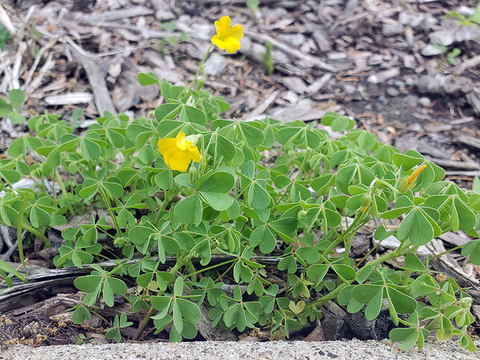Quick facts
- Yellow wood sorrel is a tender perennial that spreads by seed and rhizomes, forming mats in disturbed soils.
- Explosive seed heads allow yellow wood sorrel to spread aggressively, so control methods should be done before the plant goes to seed.
- Yellow wood sorrel can be identified by its five-petaled yellow flowers, trifoliate heart-shaped leaves, and erect stem hairs.
- Yellow wood sorrel is a common edible plant for many foragers.
Characteristics
Minnesota has several different species of wood sorrel, but the most common is yellow wood sorrel (Oxalis stricta). Believed to be native to North America, yellow wood sorrel is a low-growing, weak perennial member of the Oxalidaceae family (wood sorrels) that grows individually and in mats.
Typically growing between 6 and 12 inches, yellow wood sorrel can aggressively spread by rhizomes and seeds.
Flowers, fruit and seeds
- Bloom time: spring to early fall.
- Yellow wood sorrel blooms consist of five-petaled yellow flowers growing singularly or in small clusters at the end of stalks.
- Hairy, ridged seed capsules can produce thousands of seeds a year.
- Mature yellow wood sorrel seed capsules explode when touched, launching seeds several feet.
- Yellow wood sorrel seeds are entirely brown and ridged.
Leaves
- Wood sorrel has trifoliate green (three leaflets) heart-shaped leaves.
- Heart-shaped leaves are an easy way to discern wood sorrel from clover.
- Yellow wood sorrel leaves are often folded down the midrib (center vein).
- Alternate growth.
Stem and roots
- Wood sorrel stems can form both upright and horizontally along the ground.
- Yellow wood sorrel stems have spreading or erect hairs (come off the stem at 45-90 degrees).
- Southern wood sorrel also known as slender yellow wood sorrel (Oxalis dillenii) has hairs that lie flat (appressed) all along the stem.
- Rhizomes (horizontal underground stems) can produce new plants from nodes.
- Creeping wood sorrel (Oxalis corniculata) has stolons (above-ground stems that root at nodes), unlike yellow wood sorrel (Oxalis stricta).
Where it thrives
Yellow wood sorrel thrives in moist, partially shaded environments but is adaptable to most ranges of light and moisture. The plant’s adaptability, combined with its reproduction methods, allows it to spread vigorously.
Yellow wood sorrel grows in lawns and gardens but can also be found in potted plants, sidewalk cracks, and other unexpected locations with disturbed soil.
Control and management
Yellow wood sorrel rhizomes can produce new plants, and their explosive seed heads can cause aggressive spreading.
Turf
- Hand removal is effective for individual plants or small patches.
- Remove as much of the root and rhizome as possible to prevent regrowth.
- Remove before plants go to seed.
- A dense and healthy turf is the best defense against yellow wood sorrel encroachment.
- Increasing turf density can help mitigate wood sorrel germination and growth.
- Pre-emergent herbicides:
- Pendimethalin, Balan + trifluralin, Balan, Dithiopyr, Prodiamine, Corn gluten meal
- Post-emergent herbicides:
- MCPA, fluroxypyr, triclopyr, carfentrazone, topremazone
Garden
- Hand removal is effective for individual plants or small patches.
- Remove as much of the root and rhizome as possible to prevent regrowth.
- Remove before plants go to seed.
- Mulching can be beneficial in reducing seed germination.
- Pre-emergent herbicides:
- Trifluralin
- Oryzalin
Benefits to the landscape
Yellow wood sorrel is an edible landscape weed enjoyed for its sour flavor but is also known to contain high amounts of oxalates, known to cause kidney issues.
Small bees and other pollinators collect yellow wood sorrel pollen and nectar. Birds and mammals are also known to feed on the flower’s seed.
Conservation, invasive status and native status
- Believed to be native to North America.
- Seed samples of Oxalis stricta were sent to Europe from Virginia as early as 1680; however, arguments have been made regarding the origins of yellow wood sorrel being in Asia.
- Yellow wood sorrel (Oxalis stricta) is commonly confused with creeping wood sorrel (Oxalis corniculata) and Southern wood sorrel (Oxalis dillenii) by taxonomists throughout history.
Plants that look similar
- Southern wood sorrel (Oxalis dillenii)
- Creeping wood sorrel (Oxalis corniculata)
- Black medic
- White clover
- Birdsfoot trefoil
CAUTION: Mention of a pesticide or use of a pesticide label is for educational purposes only. Always follow the pesticide label directions attached to the pesticide container you are using. Be sure that the area you wish to treat is listed on the label of the pesticide you intend to use. Remember, the label is the law.
Groom, Q. J., Van der Straeten, J., & Hoste, I. (2019). The origin of Oxalis corniculata L. PeerJ 7. https://doi.org/10.7717/peerj.6384
Landschoot, P., Abbey, T., & Delvalle, T. Lawn and turfgrass weeds: Yellow Woodsorrel, Oxalis stricta L. Penn State Extension. https://extension.psu.edu/lawn-and-turfgrass-weeds-yellow-woodsorrel-oxalis-stricta-l
Lollar, M., & Marble, C. (2022, February 8). ENH1253/EP514: Biology and management of Oxalis (oxalis stricta) in ornamental crop production. Ask IFAS. https://edis.ifas.ufl.edu/publication/EP514
Taylor, D. Common Yellow Wood Sorrel (Oxalis stricta). U.S. Forest Service. https://www.fs.usda.gov/wildflowers/plant-of-the-week/oxalis_stricta.shtml
University of Missouri Division of Plant Sciences. (n.d.). Creeping Red Woodsorrel. Mizzou WeedID. https://weedid.missouri.edu/weedinfo.cfm?weed_id=193
Reviewed in 2024


